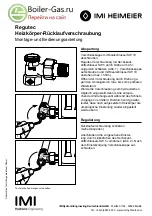
– Hold the air duct at the plain end, and slide the flue duct
(small duct) inside the air duct (terminal first) until it stops
against the terminal, then mark off the length to be cut
which leaves 20 mm protruding flue duct.
– Remove and cut the flue duct square to the mark and
remove all burrs and sharp edges.
3.5
FLUE AND TERMINAL INSTALLATION
3.5.1
Installations from inside the room
Wall thicknesses up to 0.5 m (19 in) only, Hole diameter suf-
ficient to accept wall liner 130 mm (5
1
/
4
in) if optional kit is
used.
– A wall liner, 127 mm (5 in) internal diameter, 500 mm (19
in) long is available as an optional extra for use when fit-
ting the flue/air duct from inside the building, (or where it
is required to seal the hole through a cavity wall). Cut the
liner to the wall thickness, insert into the hole, and seal
with mortar at inner and outer wall faces. Access to the
outside can be made by inserting one’s hand through the
liner.
– Fit the rubber sealing ring into the swaged groove in the
air duct as shown in fig. 11. Ensure that it is the correct
way around and spray the outside surface with talcum
powder or soap solution to reduce friction.
– Push the flue duct assembly into the air duct until it stops
against the terminal.
– From inside the building slide the duct assembly into the
wall liner until the sealing ring passes completely through
the wall, then pull the air duct back until the ring is pulled
up to the wall surface.
– Procede to section 3.5.3.
3.5.2
Installations from outside the building only
(Hole diameter 100 mm - 4 in)
– Push the flue duct assembly into the air duct until it stops
against the terminal.
– From inside or outside the building, slide the duct assem-
bly into the wall until the sealing ring forms a good seal
against the outside wall.
– Fit the rubber sealing ring into the swaged groove in the
air duct as shown in fig. 11. Ensure that it is the correct
way around.
3.5.3
Connecting the duct assembly - All installations
– With reference to fig. 11, slide on the rubber ring (D),
check that the rubber sealing ring (E) is pulled up to the
wall and that the duct assembly is horizontal.
– Push the junction collar (B) over the air duct until the air
duct touches the inner part of the collar where the diame-
ter becomes smaller.
– Push the elbow socket into the junction collar and onto
the flue duct.
– Fit the protective metal collar (G) over the juction collar.
– Place the gasket (F) under the flange of the elbow and fit
the elbow onto the air smoke manifold, taking care to
ensure that the silicon seal on the elbow correctly
engages and forms a seal at its joint with the manifold.
– Secure the elbow onto the air/smoke manifold using the
four screws provided.
3.5.4
Coaxial flue diaphragm
The boiler is normally supplied with Ø 87.5 diaphragm. Insert
the diaphragm only if the length of the coaxial flue is less
than 1.8 metres in model
“FORMAT 80 C”
or 1.5 metres in
model
“FORMAT 100 C”
. Refer to fig. 12 for positioning.
10
KEY
A
Elbow
B
Junction collar
C
Outer duct
D
Inner rubber sealing ring
E
Outer rubber sealing ring
F
Neoprene gasket
G
Protective metal collar
H
Inner lip seal
Fig. 11
Fig. 12
IMPORTANT: Install diaphragm Ø 87.5 only
if the coaxial flue is less than 1.8 metres
long for model “FORMAT 80 C” or 1.5
metres long for model “FORMAT 100 C”.
Summary of Contents for Murelle 25 BF
Page 24: ...Format C installation and servicing instructions...
Page 53: ...26...
















































